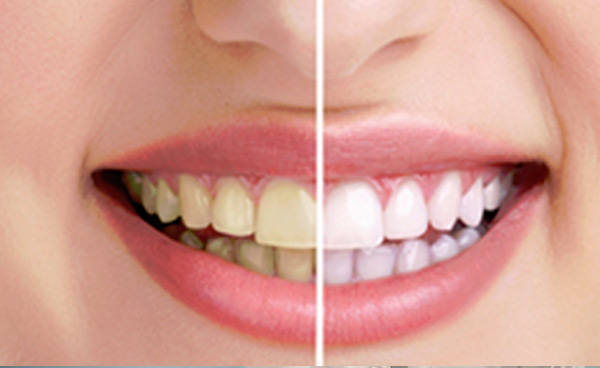Veneers and restoration
Rediscover the beauty of your smile
“Aesthetic” dental restorations are the result of increasingly-more modern and effective technology, which makes it possible to create or restore a great smile. Thanks to new technologies that work with videos, photographs and temporary 2D/3D models, dentists can also offer you prostheses that ensure an optimal relationship between your lips, gums and teeth. The 3D and virtual renderings available to patients enable them to visualize their new smile in advance, and even facilitate their decision-making.
The choice of restorations between veneers, crowns or bridges is based on the state of the dentition and the patient’s health, as well as the nature of the improvement or replacement desired.
Choose your most beautiful smile with advice from Dr. Lechner
The shape of your teeth
You can choose the different tooth shapes that suit you best. 12 options for arranging the most popular tooth shapes.
The color of veneers
- Very light and luminous white
- White a little dark and natural
- White a little tinged with yellow for warmth and naturalness
- White with a slightly gray tint, for a fresher look.
- White with darker, more pigmented shades, for a more colorful and natural look
The opacity of veneers
- Firm 90% opacity
- Universal firm 85% opacity
- Gleaming 80% opacity
- Clear 50% opacity
Overview of the different treatments
Veneers
To restore teeth that are stained, discoloured, deformed, or slightly deteriorated by wear, porcelain veneers are a popular restorative technique with adult patients of all ages. These thin shells cover the front of the teeth and are used to correct the contour, colour and shape to further improve your smile’s appearance. This restoration is increasingly in demand, since it helps you obtain whiter teeth without defects in colour or shape. The veneers are made of either porcelain or composite, and your dentist will recommend the best material for you, considering, for example, the possibility of having to place a crown on an adjacent tooth that is already weakened, etc.
When should you choose veneers?
When a tooth’s shape or colour is very altered and fits poorly into the aesthetics of your mouth or smile, composite restorations (such as a white filling) cannot mask all the defects. Veneers can achieve perfect and harmonious visual integration, while being less invasive than a crown. Indeed, bonded veneers have less impact on the healthy parts of the tooth, have less impact on dental pulp and are more biocompatible than metal alloys.
This technology produces excellent results, both aesthetic and mechanical. In terms of aesthetics, veneers make it possible to obtain a great resemblance to natural teeth, an important advantage. In terms of longevity, they have demonstrated a high rate of success and stability over the medium and long term.
Crowns
A crown is a restoration that completely covers a damaged tooth, whether through wear, accident or decay, and mimics the shape of the replaced tooth. The dentist must first cut part of the natural tooth to make room for the crown, which protects the natural tooth and restores it to its original colour and shape. There are three types of materials used in the manufacture of crowns:
- Metal crowns
- Ceramic crowns
- Ceramo-metal alloy (a combination of ceramic and metal)
When do you need a crown?
Your dentist will recommend a crown for one of the following reasons:
- To cover and support a tooth that is still healthy when a filling becomes too big.
- To protect a tooth weakened by decay, wear, etc. against the risk of breakage.
- To restore a broken or badly-worn tooth.
- To cover a severely discoloured tooth, after a root canal, for example.
- To restore functionality and appearance to a badly-formed tooth.
- To serve as a pillar adjacent to a fixed or butterfly bridge.
- To cover the root following the installation of an implant or a post.
Fixed-bridge
It is important to replace a tooth that has been extracted. A fixed bridge is one of the options available to patients who have had one or more teeth extracted or lost. This type of bridge makes it possible to prevent the displacement and possible loosening of the other teeth; it aids chewing and therefore digestion, it preserves the aesthetics of the smile, and it prevents temporomandibular joint problems.
If a single tooth needs to be replaced, the patient has two choices:
- A conventional bridge formed of crowns fused together and cemented to the pillars (pivots and crowns) of the bridge to hold it in place. Root canal treatment should be considered for any adjacent pillar tooth that is already weakened.
- A butterfly bridge that is supported by metal fins/wings attached to adjacent teeth. This is less solid than a conventional bridge, bit it better preserves the teeth that serve as its pillars.
When fabricating a fixed bridge, the patient will need to wear a temporary bridge to immediately protect their teeth and gums. The temporary bridge will prevent the pillar teeth from moving and will maintain the patient’s masticatory and speech capacity. The temporary bridge also helps in the design of the final bridge, as its function and appearance can be tested beforehand.
Treatment steps
An Informed Consent Form must be signed before beginning any of the following treatments.
Veneers
The treatment plan related to veneers can change from one patient to another, since the goal is to look at the overall aesthetic of the mouth and smile. Various parameters influence the choices and steps, such as:
- The patient’s age, since our teeth become darker with age.
- The teeth’s natural colouring, which can range from yellowish to grayish.
- The position and alignment of the tooth to be corrected.
- The location where the tooth is discoloured, if applicable.
- Occlusion of the mouth.
- Healthy gums.
- The desire to preserve existing tissues (healthy parts of the tooth), etc.
Finally, the patient’s willingness to maintain an oral hygiene routine, including regular cleaning at the dentist, will be one of the factors for the success (or not) of the veneers over the medium and long term.
Smile TrialTM and Digital Smile DesignTM
Initial exam
Your dentist will perform an oral examination with X-rays and 3D scanning to assess the condition and position of the tooth to be restored, as well as its harmony with the adjacent teeth. The condition of the gums around the tooth is also to be considered and your dentist may recommend beginning the treatments with a prior reconfiguration of the gum by means of periodontal surgery, a gingival graft or other.
Your dentist will take 3D photos and/or videos of your face, in order to superimpose the planned restorations and to provide an approximate but realistic preview of your facial features after the treatment.
First fitting – After 2 to 3 weeks
This step will be followed by the fabrication of a 2D/3D predictive model in an external laboratory,
then adjustment and approval before computer fabrication of the final crown or veneer (restoration).
Tooth or teeth preparation – Week 4
Tooth preparation
The tooth’s position in the mouth and other aesthetic considerations may lead the dentist to prepare the tooth intended to receive a restoration, for example by trimming the tooth. If it is too damaged, or there is too much pain or inflammation, your dentist may recommend a root canal treatment beforehand, with the installation of a post cemented into the root upon which to seat the restoration. The preparation of the tooth/teeth is done based on the 2D/3D predictive model from the previous visit.
Temporary crown
The installation of a temporary crown is important and contributes to the treatment’s final success. This crown will be cemented to ensure sufficient strength, while being able to be removed as often as required during the processing steps. The temporary crown has several roles. It helps:
- Protect the tooth and gums against mechanical dangers (chewing or otherwise), the risk of oral infection, etc.
- Prevent neighbouring teeth from moving or shifting.
- Preserve the ability to chew and speak.
- Assist in the design of the final crown.
- Enable testing the final crown’s function and appearance, and to make any manufacturing adjustments.
Final crown and follow-up – Week 6
The final crown will be fitted and installed upon receipt of the prosthesis from the external laboratory. If the result is satisfactory for everyone, the crown is permanently cemented. If a problem is detected, the final crown is returned for adjustment and the temporary crown is re-inserted.
Follow-up visits – Week 8 and afterwards
A check-up X-ray is taken to make sure the fit is correct. The patient may experience temporary tenderness after installation, the causes of which are checked out during this visit. If the sensitivity persists, root canal treatment may be considered and recommended.
Fixed bridge
Examen initial
The dentist performs a medical check-up including a clinical examination and one or more x-rays. The condition of the gums is examined, both under the missing/to be extracted tooth and under the adjacent teeth, which will serve as pillars, in order to determine the amount of soft tissue available. In the event of receding gums and other periodontal diseases, a recommendation for reconfiguration and surgery would be made at this stage.
Teeth preparation
The pillar tooth is cut and prepared for the installation of crowns and/or posts. If the pillar tooth is too damaged, a root canal treatment may be considered at this stage. To seat the crown of the bridge’s pillar tooth, a cemented post will be installed in this tooth’s root as part of the preparation.
Temporary bridge – Healing phase
When manufacturing a fixed bridge, the patient will need to wear a temporary bridge to immediately protect their teeth and gums. The temporary bridge will prevent the pillar teeth from moving and retain the ability to chew and speak properly. The temporary bridge also helps in the design of the final bridge, as its function and aesthetics can be tested. The temporary bridge is cemented to prevent it from falling out or being lost, while enabling the dentist to remove it as often as necessary to proceed with the fitting and adjustment of the final bridge, treatment of the pillar teeth, etc.
Final bridge and follow-up – Week xxx
The fitting and installation of the final bridge are carried out upon receipt of the prosthesis from the external laboratory. If the result is satisfactory for everyone, the bridge is permanently cemented to the pillar tooth/teeth. If a problem is detected, the final bridge is returned for adjustment and the temporary bridge is put back into place.
Check-ups – Weeks 2-4 and afterwards
A check-up X-ray is taken to ensure a correct fit. The patient may experience temporary tenderness after installation, the causes of which are checked out during this visit. If the sensitivity persists, various treatments may be considered, such as a root canal treatment on the pillar tooth, etc.
Advantages, risks and disadvantages
Advantages and disadvantages of veneers
Veneers are preferred if the patient has multiple coloured teeth after taking medication. They are also a good solution for any enamel defect such as decalcification, premature wear of the tooth contour, the failure of fillings on the front teeth or to “close” gaps between teeth or those with the famous black “triangle” near the gum line.
Veneers also have disadvantages. In general, they are contraindicated in cases of extreme wear or overlap, problems with tooth structure or in the presence of oral habits that interfere with normal function, such as untreated bruxism. Unlike a filling, they require more than one appointment and can increase wear on opposing top or bottom teeth. Porcelain veneers have less strength than a ¾ or full crown. Also, they are not suitable for patients looking for reversible treatments.
During any future surgery in which the patient could be intubated, this intubation must be done through the nose and not the mouth, in order not to damage the veneers. You must be sure to mention this in the preoperative medical questionnaire provided by your healthcare professional.
Advantages and disadvantages of crowns
The installation of a crown poses a mechanical risk with varying consequences, depending on the case. A crown may loosen and begin to move over time, without fracture as a cause or consequence. Resealing or re-cementing can usually be completed without any issues. If the loosening is due to decay or a poor fit, the crown may need to be redone. When fitting the crown to the root, including the installation of a post, a root fracture can occur and generally requires the tooth to be extracted. The tooth material, such as ceramic, can break for various reasons (wear, bruxism, decay, chewing accident, etc.).
If postoperative discomfort is to be expected, as with any surgery, prolonged postoperative pain on a vital tooth may require root canal treatment. The tooth may “die” during the preliminary grinding to fit the crown.
The average lifespan of a crown is estimated at 10 years, provided the patient maintains good oral hygiene. During any future surgery, where the patient could be intubated, this intubation must be done through the nose and not the mouth, in order not to damage the crown. You must be sure to mention this in the preoperative medical questionnaire provided by your health establishment.
Advantages and disadvantages of fixed bridges
The fixed bridge has the advantage of facilitating the patient’s ability to chew and speak, in addition to preserving a normal smile aesthetic. It also helps prevent displacement of adjacent teeth and damage to soft gum tissue. On the other hand, the preparation treatment of the adjacent abutment teeth increases the risk of cavities and endodontic treatment. This is why disciplined dental hygiene is required.
In the presence of a broken tooth that must be extracted before the placement of a bridge, the first step consists of an extraction which presents certain temporary discomforts: temporary swelling of the cheek or bruising (7 to 10 days), postoperative pain or light bleeding.
During any future surgery, where the patient could be intubated, this intubation must be done through the nose or not the mouth, in order not to damage the bridge. Make sure to mention it in the preoperative medical questionnaire given by the health establishment.
Before and after photos
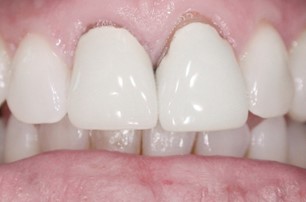
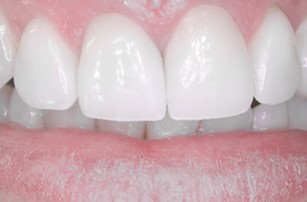
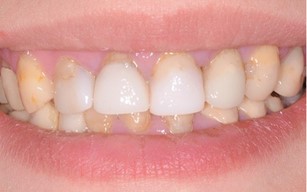
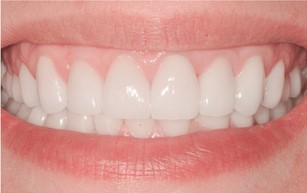
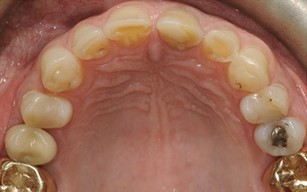
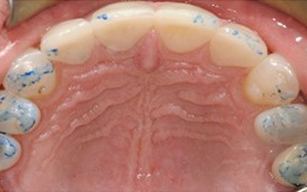
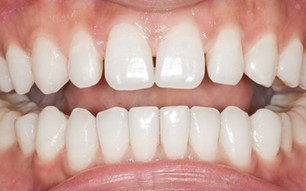
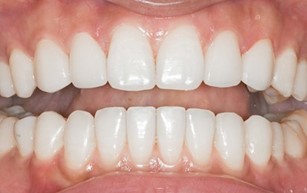
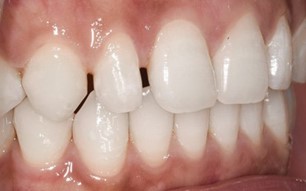
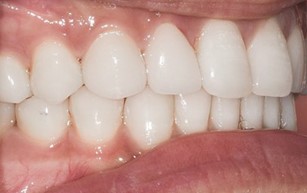
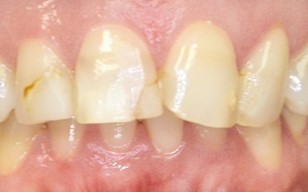
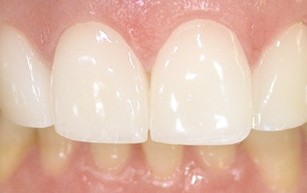
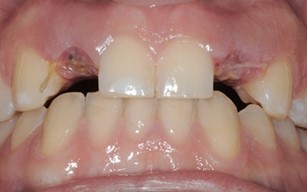
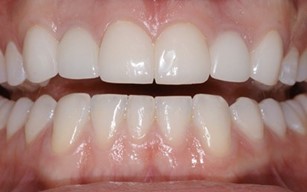
Restorations maintenance
Like the teeth they replace, veneers, crowns and fixed bridges need to be well maintained. This means
that patients must adhere to excellent oral hygiene and visit their dentist regularly.
During biennial visits, your Prisma dentist can check the condition of the restorations and descale them along with your natural teeth. This will prevent any build-up of bacterial plaque which can lead to complications, or even treatment failure. For example, the buildup of bacterial plaque that sneaks under the gum tissue can cause craters around restorations. Periodontics, a disease manifested by loss of bone supporting teeth and implants, can lead to loss of restorations.
Other recommended dental treatments
As we have seen, your Prisma dentist could recommend various treatments prior to the installation of a veneer, crown or bridge, such as root canal treatment or periodontal (gum) surgery. Whitening before fitting to harmonize your teeth or being fitted with bite plate to prevent your teeth from grinding on the veneers are also part of the treatments to be discussed.
Teeth whitening
An effective complementary solution to maximize your new smile’s radiance is teeth whitening. This can correct teeth discolouration or yellowing and can be performed at the Prisma clinic and/or at home.
Teeth whitening performed in a clinic is a long-lasting and minimally-intrusive solution. A progression of several shades is possible in one visit, thanks to the use of professional gels that contain active whitening ingredients combined with oxygen molecules. As a result, these gels penetrate through the enamel to separate the molecules responsible for the colour change and brighten the teeth. The effect is instantaneous.
Bite plates
Bruxism, commonly known as “teeth grinding” occurs during the day or night, although it is more common during sleep and therefore more difficult to control. In terms of dental aesthetics, it can cause, among other things, wear of the dentition, which can go as far as fracturing your teeth or your restorations (fillings, veneers, crowns, etc.).
To prevent such damage, your Prisma dentist may recommend that you wear a dental protector or bite plate, made to measure according to your teeth.




